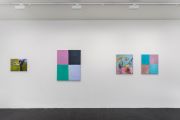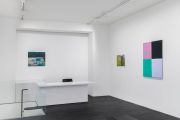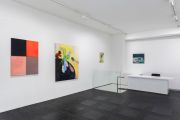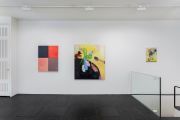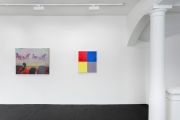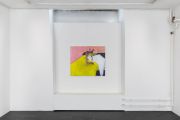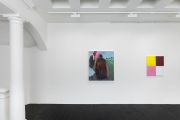Rosalind Nashashibi
Tender Horse
Press release
By Adam Szymczyk
The London-born and -based artist of Palestinian origin, Rosalind Nashashibi, is showing a recent group of paintings in her first solo exhibition at Galerie Urs Meile at Rämistrasse. Concurrently, her 2007 film Bachelor Machines Part 1 is featured in a group show at the gallery’s new space in Ankerstrasse. The thirty-one-minute 16 mm film, shot on a cargo ship on the way from Southern Italy to Sweden, borrows its title not only from one of the sections of The Bride Stripped Bare by Her Bachelors, Even (La Mariée mise à nu par ses célibataires, même), commonly known as Le Grande Verre (The Large Glass), the 1915–23 work by Marcel Duchamp, but also from Michel Carrouges’s book Les Machines célibataires (1954), and the eponymous exhibition curated by Harald Szeemann in 1975. Nashashibi’s film is an anti-epic of a sea journey undertaken by a female filmmaker observing the daily chores of an all-male crew toiling on board their ship, the ultimate bachelor machine. In its embodied scrutiny of gender roles, the work prefigures another film, Why Are You Angry? (2017), currently on view at Kunsthaus Zürich and realised by Nashashibi/Skaer (an artist duo consisting of Nashashibi and Lucy Skaer), in which Paul Gauguin’s painterly exploits in Tahiti are critically retold by two female artists who feature contemporary Tahitian women as they drive cars and buy food between casual reenactments of the poses struck by Gauguin’s models.
Since the late 1990s, Nashashibi’s work has encompassed film projects, photographs, prints, paintings, drawings, and more. Her work is neither organised around a single narration, nor does it follow one thematic concern—other than being a constant inquiry into the personal circumstances and political dimensions of daily life: its minor histories, major dramas, and the sudden short circuits between the two that render the private public. Often, apparently mundane motifs in her paintings can be traced back to nineteenth-century realist, impressionist, and, later, post-impressionist depictions of modern life by mostly male painters—including, but not limited to, Pierre Bonnard, Gustave Caillebotte, Edgar Degas, and Claude Monet. But they also include allusions to protagonists and objects portrayed in Nashashibi’s films, such as Stone and Table (2004), which shows just these two titular objects and a shadow passing over. In the 2025 paintings Vase with Flowers, Hand with Stone and Chrysanthemums, Hand with Stone, a hand calmly but firmly grips a stone next to a table and a vase of flowers; contemplation and violence are just a stone’s throw from each other. In Nashashibi’s works, genres and motifs borrowed from modern painting blend together with our contemporariness: a horse, a dog, a nude on a sofa, a catalogue spread with a painting of a nude on a sofa (A Book Left Out, 2025), a flower bouquet on a table, a hand with a stone, a horse again, bespectacled spectators at a theatre spectacle—facing a curtain adorned with a pattern of horse-drawn carriages instead of looking at Degas’s ballerinas (At the Theatre, 2025). These details are culled from the history of modern art and extracted and reframed as part of Nashashibi’s own compositions.
Restaged, they perform in new configurations. In The Painting Lesson (2025), a young woman, doll-like, reclines on an oversized sofa—a retake on Gustave Caillebotte’s Nu au divan (Nude on a Couch, c. 1880)—with an additional slender ghostly figure of an elderly woman; a painter at work, a shadow, or an alter ego emanating from the protagonist’s dream. Another work by Nashashibi is an inversion of that same painting by Caillebotte (Thought, 2025). It depicts a brown-skinned woman in a white dress who is seated on a yellow couch and stares pensively into space (Caillebotte’s nude white woman hides her face under her arm, in a conventional expression of shame, or perhaps just tiredness). Behind Nashashibi’s figure, an image of a jockey on a horse materialises in the corner of the room as an undecided apparition between a painting-in-a-painting, a thought bubble, or a large oval lens—the yellow colour of the sofa bleeding into the ground under the horse’s legs.
Entitled, somewhat cryptically, Tender Horse, the show also includes paintings with grids of four colour fields: Rose Black, Lilac Green, Ruby White, Turquoise Pink, and Red Blue (all 2025). Seen next to other, more obviously ‘representational’ works (such that they, by definition, ‘represent something’, as if it was possible to not represent something), these seem familiar in their imperfection, which does not allow for them to be qualified as entirely abstract. Reminiscent of colour charts, they might also be figurative works painted over, or extractions of colours from earlier paintings that dissolved in them. The fields of red, blue, yellow, and lilac, or lilac, black, green, and blue, form four-fold surfaces, with other colours coming through under the layers of paint, and thin lines or gaps between the rectangular shapes also shining through from below. Our attempts at creating an image of colour in words unavoidably remind us of Ludwig Wittgenstein’s remark: ‘Our ordinary language has no means for describing a particular shade of colour. Thus, it is incapable of producing a picture of this colour.’
Symmetries and asymmetries, repetitions and shifts of motifs organise the works—not along binary opposites but rather exposing complementary, attracting forces in inexact reflections, almost oppositions: a painting of two fish mirroring each other heraldically on a plate has been painted over with a pink water lily against a rectangular yellow backdrop adjoining a pink water lily against a black backdrop (Lilies, 2025); two horse carriages adorn the curtain that hides yet another play before the audience’s eyes; two swans (Departure, 2025), et cetera. Nashashibi’s painting is not a zero-sum game with the history of the medium. She critically revisits painting to probe its worn habits and expose its ideological codes. The painting of the woman on the yellow sofa (Thought) counters the vaguely orientalising erotic fantasy of Caillebotte’s ‘divan’: It is based on an image included in an art book project by Ania Dabrowska, of a young, modern Arab woman seated on a sofa in a private home. A Lebanese Archive: From the Collection of Diab Alkarssifi (Book Works, 2015) re-presents and recontextualises the private archive of a Lebanese émigré in London, consisting of family photographs of daily scenes in Lebanon throughout the last century. One image migrated, via Caillebotte’s painting, into Nashashibi’s own work—or perhaps it was Caillebotte’s painting that migrated into Nashashibi’s via the archival image included by Dabrowska in A Lebanese Archive.
A show’s title should connect all its diverse threads—and here it does so in the most personal way. Tender Horse draws on the etymology of Nashashibi’s first name, derived from the Old German words ‘hros’ (horse) and ‘lind’ (tender, soft). Perhaps it also hints at Degas’s horseracing paintings, those scenes from the bourgeois life of men looking at men on horses. Just think of Jockey blessé (Injured Jockey, 1896–98), stretched helplessly on the green grass in his intensely yellow trousers, his horse above him running away.
British Palestinian artist Rosalind Nashashibi (*1973, London, UK) is a painter and filmmaker. In both media she is preoccupied with looking, to the extent of passing over onto the side of the subject in a way that can be disconcerting and yet deeply empathetic. Her films are often non-linear, punctuated by manifestations of power dynamics and collective histories. In her painting, sentimental or overloaded motifs such as a pair of swans or a X, intrigue us into looking at them anew, and her references to historical paintings are dives into the past to bring back new experiences.
June 13 – August 23, 2025
Galerie Urs Meile Zurich, Rämistrasse
Opening:
Saturday, June 14, 2025: 17 – 19h
Downloads
Opening hours:
Wednesday – Friday, 11 –18h
Saturday, 11 – 17h

